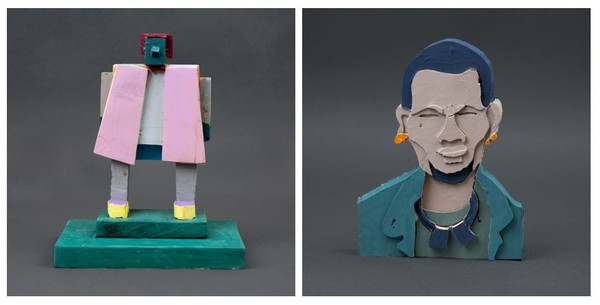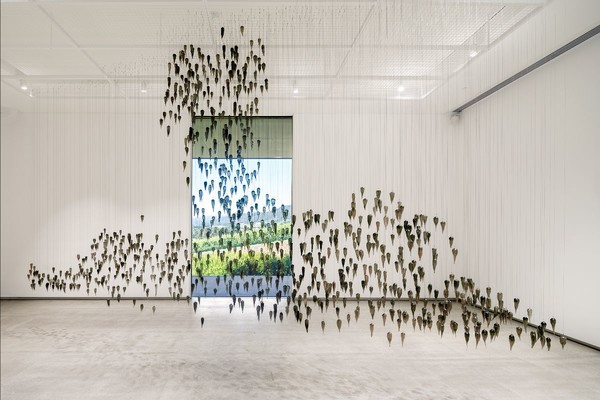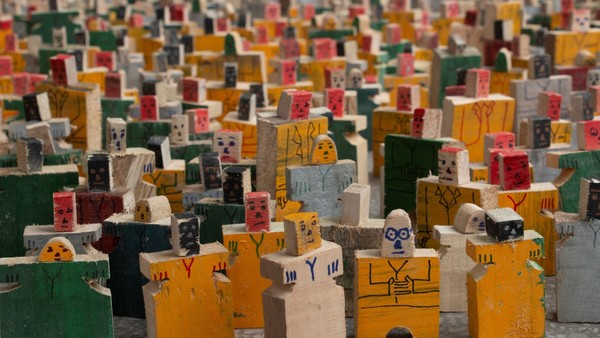10 June – 29 August 2022

[아츠앤컬쳐] Haffendi Anuar, Abdulrazaq Awofeso, Yhonnie Scarce, Salote Tawale and Osman Yousefzada
IKON 갤러리는 6월 10일~8월 29일까지 이 다섯 작가의 작품을 선보인다. 작가들은 사람과 아이디어의 국제적 이동에 관심을 갖고 참가했으며, 버밍엄 2022 커먼웰스 게임에 맞춰 조직되었다.
IKON 1층에서는 호주 원주민 예술가 Yhonnie Scarce의 매달린 유리 설치물인 The Near Breeder(2022)를 선보인다. 사우스오스트레일리아 우메라 출신의 스카스는 코카타족과 누쿠누족에 속한다. 유리를 사용하여 작업하면서, 그녀는 특히 1956년부터 1963년까지 우메라 금지 구역에 속했던 마를링가에서 자행된 영국 핵 실험의 결과로 사막 모래의 결정화가 이루어진 물질의 정치적, 미적 특성을 탐구한다.
니어 브리더(Near Breeder)는 원주민 음식의 원초적 야채이자 "국가"와의 연결을 상징하는 참마를 닮은 약 800개의 개별 손으로 불린 유리로 구성되어 있다. 천장에 매달려 있는 그들은 폭발과 역류하는 물방울 구름을 불러 일으켜 핵 실험으로 인한 많은 죽음을 의미한다. 울버햄프턴 대학교에서 제작된 이 작품은 TarraWarra 미술관 및 컨설턴트 큐레이터 Hetti Perkins와 협력하여 개발한 Scarce의 IKON 레지던시(2020-22)의 정점이라 할 수 있다. 환경에 대한 Scarce의 관심은 그룹 전시회 Reclaim the Earth(2022년 4월 15일 – 9월 4일)의 일환으로 Ikon과 공동으로 Palais de Tokyo에서 동시 프레젠테이션에 반영되었다.
또한 IKON의 1층에는 피지-호주 예술가 Salote Tawale와 영국-아프가니스탄 예술가 Osman Yousefzada의 작품이 영국/호주 시즌 2021-22의 일환으로 전시되어 있으며, 이는 양국 간의 역대 최대 규모의 문화 교류다.
Made in Birmingham/Made in Sydney는 버밍엄의 IKON과 시드니의 MCA(Museum of Contemporary Art Australia) 간의 획기적인 협업으로 Tawale와 Yousefzada가 두 개의 새로운 비디오 작품을 통해 정체성과 소속감에 대한 질문을 탐구한다.
This exhibition at Ikon Gallery brings together work by five artists: Haffendi Anuar, Abdulrazaq Awofeso, Yhonnie Scarce, Salote Tawale and Osman Yousefzada (10 June – 29 August 2022). Each is a participant in Ikon’s Arrivals programme, concerned with the international movement of people and ideas and organised to coincide with the Birmingham 2022 Commonwealth Games.
On Ikon’s first floor, Australian Aboriginal artist Yhonnie Scarce presents a major new suspended glass installation, The Near Breeder (2022). Born in Woomera, South Australia, Scarce belongs to the Kokatha and Nukunu peoples. Working with glass, she explores the political nature and aesthetic qualities of the material – in particular corresponding to the crystallisation of desert sand as a result of British nuclear tests during 1956-63 in Maralinga, formerly part of the Woomera Prohibited Area.
The Near Breeder comprises approximately 800 individually hand-blown glass that resemble yams, a primordial vegetable in Aboriginal food and a symbol of the connection to “Country”. Hanging from the ceiling, they evoke both an explosion and a cloud of inverted water drops, marking the many deaths resulting from nuclear testing. The work, produced at the University of Wolverhampton, is the culmination of Scarce’s Ikon residency (2020-22), developed in partnership with TarraWarra Museum of Art and consultant curator Hetti Perkins. Scarce’s concern for the environment is reflected in a simultaneous presentation at Palais de Tokyo - in collaboration with Ikon - as part of a group exhibition Reclaim the Earth (15 April – 4 September 2022).
Also on Ikon’s first floor is the work of Fijian-Australian artist Salote Tawale and British-Afghan artist Osman Yousefzada as part of the UK/Australia Season 2021-22, the largest ever cultural exchange between the two nations. Made in Birmingham/Made in Sydney is a ground-breaking collaboration between Ikon in Birmingham and the Museum of Contemporary Art Australia (MCA) in Sydney, through which Tawale and Yousefzada explore questions of identity and belonging via two new video artworks.

|
Salote Tawale's work YOU, ME, ME, YOU (2022) features footage made by the artist, family and friends; it is a montage of imagery that combines role-play, television reenactments, social media posts and an imaginary pop music video. Exploring themes of proximity, distance and friendship, this new work includes a cast of collaborators, from Tawale's relatives, to her artist friends, the queer community in Australia and a chosen family of individuals who have been brought together by diasporic contexts, living and working away from homelands. Re-performing aspects of their shared experiences, the participants depict the loneliness, comfort, inspiration and support found within these familial and friendship networks during a period of isolation and restriction due to COVID-19. Tawale’s video is a dedication to these important relationships in all their forms and a celebration of how our differences can unite us during difficult times. 
This summer Ikon presents a solo exhibition, OUT OF FRAME, by Nigerian artist Abdulrazaq Awofeso. Having recently arrived in Birmingham from Lagos, Awofeso shows all new work as part of Ikon’s Arrivals programme (June - August), concerned with the international movement of people and ideas and organised to coincide with the Birmingham 2022 Commonwealth Games. |

